As the power of laboratory lasers has increased, aspheric lenses and mirrors have been pushed to deliver exceptionally high intensities.
ARIS KOURIS, OPTICAL SURFACES LTD.
Editor’s note: This is Part 1 of a two-part feature on optics for nuclear research. Part 1 takes a brief look at high-power laser facilities. It also demonstrates the critical role of aspheric optics in these demanding conditions. Part 2, which will run in the October issue, discusses the technical requirements and manufacturing challenges of mirrors and lenses in facilities that use high-power lasers. Coatings and materials choices will also be addressed.
Nuclear research laser facilities around the world increasingly use powerful, amplified, ultrashort-duration pulses of coherent light to deliver massive energy densities at a given target. The synchronized delivery of such high-power pulses generates extreme conditions that allow scientists to carry out state-of-the-art nuclear research. It also enables the study of conditions that exist only in exotic and distant environments, such as the core of our sun and beyond. These facilities enable researchers to advance knowledge in fields such as particle and nuclear physics, materials science, and astrophysics, with applications that range from nuclear energy to medicine.
It has been 10 years since the construction and commissioning of the National Ignition Facility (NIF) at Lawrence Livermore National Laboratory in the U.S. Yet the holy grail of harnessing nuclear energy through a self-sustaining fusion reaction to address the global energy crisis has not been attained. It is, however, undoubtable that NIF and other laser facilities around the world have enabled scientists to perform groundbreaking research, which has expanded our understanding of what is essential to achieve laser-induced fusion in the future.
Achievements in laser technologies have been remarkable. It would, however, be hard to realize such advancements if equal progression had not been made in the design and manufacture of optics, whether reflective or transmissive. The quality of the optics is one of the greatest determinants of delivered beam quality.
High-power laser systems
A nuclear research laser system is typically composed of a series of beamlines through which beams propagate and undergo expansion, power amplification, and spatial filtering before they end at the focusing units. Focusing units are adjacent to the vacuum chamber, which contains the target assembly and the diagnostic instruments.
The target assembly is a critical component because it contains the fuel capsule responsible for initiating the nuclear reaction. The assembly is composed of a cylindrical cell (the hohlraum), a spherical fuel capsule containing the fuel of choice, and the fuel itself.
While beam propagation and expansion is often achieved with a series of telescopic optics, the power amplification is typically achieved with a stack of neodymium-doped phosphate glass slabs and an array of powerful flashlamps. Flashlamps excite the neodymium atoms to a higher energy state so that when a low-energy laser pulse from the injection laser system passes through the slabs, the extra energy stored within the neodymium atoms is released into the laser pulse in the form of highly coherent light of a specific wavelength.
The pulse power amplification is repeated multiple times for each beam as it travels back and forth through the same sets of optics and glass slabs (a multipass scheme). However, all beamlines undergo amplification in parallel through the use of separate though identical beam-propagation subsystems dedicated to each beam.
The aim is to simultaneously deliver a densely focused spot of coherent light from each beamline inside the vacuum chamber where the fuel capsule is located. The simultaneous, spatially, and temporally coincident arrival of all the generated spots, at a very high precision, is of paramount importance. It is this precise coincidence of the densely focused spots that allows symmetrical forces to be
applied around the fuel capsule and allows a maximum energy density to be delivered to the target — both important requirements for meeting the necessary conditions that would initiate a fusion reaction.
NIF’s neodymium glass lasers generate light at 1053 nm (1ω) in the NIR region. However, the laser light is converted to its third harmonic 351 nm (3ω) prior to focusing it onto the target. The frequency conversion is accomplished with the assistance of two nonlinear crystal plates made of potassium dihydrogen phosphate (KDP). This conversion is necessary because inertial confinement fusion targets absorb UV much more efficiently as compared to longer wavelengths, and performance is better at these shorter wavelengths.
Once the UV rays are efficiently absorbed, the temperature surrounding the fuel capsule is increased immensely by the generation of secondary x-rays. Initially, this extreme local environment causes a temperature increase and ablation on the surface of the fuel capsule. The shockwaves produced during the ablation cause the capsule to collapse in a rapid implosion. It is this rapid implosion that heats the DT (deuterium and tritium) fuel to intense temperatures and compresses it to extreme densities.
As described earlier, the distribution of forces within the target — although not exclusively dependent — is heavily reliant on the precision and synchronization of the delivered beams. A successful beam delivery of a highly dense energy is likely to cause a symmetrical implosion and compression and raise the temperatures to a sufficient level (in excess of 100 million degrees). Under such temperatures, the fusion reaction equals or exceeds the laser energy deposited in the target, a condition known as ignition, or Lawson criterion.
Achieving the necessary pressure and temperature to initiate a self-sustained fusion reaction through the precise application of symmetric shockwaves, however, remains technically elusive. A technique known as “fast ignition” relaxes some of these constraints by providing an extremely short (picosecond or femtosecond) burst of energy directly at one side of the core fuel when the implosion reaches maximum density. Currently, fast ignition is being explored as a viable option that could increase the performance of inertial confinement fusion reactions.
High-power facilities
One example of an attempt to initiate self-sustaining fusion using fast ignition is the proposed European High Power laser Energy facility (HiPER). This facility is expected to be less energy-thirsty during operation than NIF, while aiming to produce significantly higher fusion gains (a thermonuclear gain of 100). The roadmap toward commissioning, however, remains uncertain until funding is secured.
The ELI Beamlines Laser Research Centre in the Czech Republic employs a number of complete laser systems — namely the L1 Alegra, L2 Amos, L3 HAPLS, and L4-Aton — with ultrashort laser pulses. These systems incorporate options of high power, high repetition rate, and up to a very high-power, single-shot (10-PW) configuration.
The ELI project has multiple objectives, but one of the main ones is to use the single-shot, ultrashort high-peak-power laser options to produce particles and radiation from relativistic and ultrarelativistic interactions. Their production will enable scientists to examine the behavior of matter at the ultrarelativistic regime, resulting in a state of matter known as quantum plasma. It is expected that the 10-PW laser at the facility will provide basic scientific research projects with a focused intensity of up to 1024 W/cm2 at
an increased dose rate. These ultrashort pulse sources are designed to serve the needs of fundamental research rather
than the pursuit of nuclear energy advancements.
Over the past 20 years, studies were conducted in the subrelativistic and relativistic regimes1,2,3. Recent efforts —
such as ELI4 and the Gemini Laser Facility, and possibly HiPER in the future — aim to address the ultrarelativistic regime, or the quantum plasma state, with expected focused intensities >1023 W/cm2 (Figure 1). Technological advancements, such as the CPA (chirped pulse amplification) technique developed in 1985, allow amplification of ultrashort pulses
to the petawatt level. And the development of solid-state lasers in the 1990s readily allowed the generation of ultrafast picosecond and femtosecond pulses, two key landmarks in the pursuit of generating relativistic and quantum plasma states.
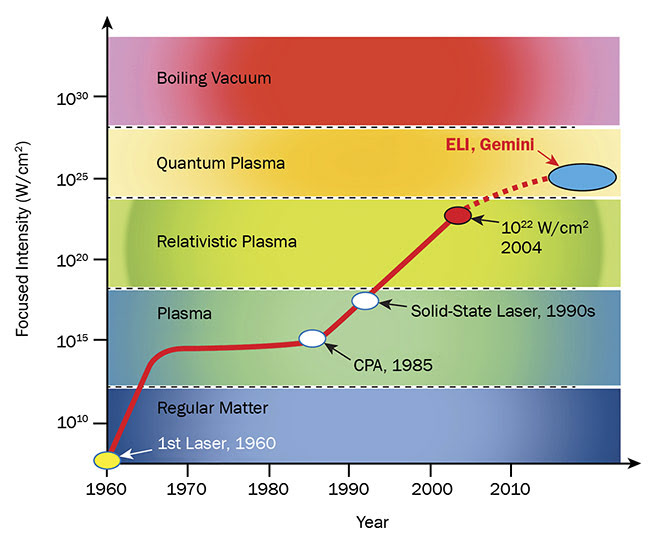
Figure 1. A history of laser intensity, with various laser-matter interaction periods. Courtesy of Optical Surfaces Ltd.
In the CPA technique, an ultrashort laser pulse is stretched out in time — prior to being introduced to the gain medium — using a pair of gratings. The gratings are arranged in such a way that the various frequency components of the laser pulse travel over unequal paths, a process called pulse stretching. It is then possible to reduce the intensity of individual parts of the spectrum, which are temporally spread, to sufficient levels to undergo amplification without damaging the gain medium by overloading it while the pulse is passing through. Finally, the stretched and amplified laser pulse is recompressed back to its original pulse width through a reversal of the process of stretching, achieving peak powers that are orders of magnitude higher than laser systems could generate before CPA (Figure 2).

Figure 2. Schematic of the CPA technique and amplification stages. Courtesy of Optical Surfaces Ltd.
Focusing optics
The focusing optics play one of the most critical roles in the successful delivery of high-density, high-uniformity distribution of energy to the target — an important aspect of all laser-based nuclear research projects. Depending on the particulars that dictate operational needs and design in each laser facility, a successful delivery can be achieved either with aspheric reflective mirrors — such as off-axis parabolas, often with a large off-axis angle — or with transmissive aspheric focusing lenses, or potentially with long-short pulse combinations of the two5.
Lasers that produce ultrashort pulses demand the use of reflective optics, since very short pulses tend to spread significantly as they transmit through the glass. In contrast, longer pulses do not exhibit significant spreading, making the use of transmissive elements such as lenses a viable option.
The effects of optical materials on the temporal spreading of an optical pulse while traveling through such materials has been extensively addressed by
M. Rosete-Aguilar and colleagues6. In this study, glasses with different chromatic dispersion characteristics were considered and their spreading was analyzed as a function of wavelength for different pulse widths. The study confirmed that the effect of the glasses on pulse temporal widening is much more severe on ultrashort pulses when compared to longer pulses (e.g., pulse lengths >>100 fs). In addition, the effect seems to be significantly more pronounced as wavelengths approach the UV (such as 351 nm). The effect reaches a near-zero minimum at a wavelength around 1.3 μm (NIR) and increases again as it approaches IR wavelengths. This behavior appears to be demonstrable in all types of glasses, but to varying degrees. Fused silica appears to exhibit the best behavior of the glasses studied6.
Considering the above, the choice of whether a transmissive or a reflective optical component should be used is heavily dependent on whether the experiments use ultrashort pulses or not. In the case of ELI, for example, where a single ultrashort pulse is used, a reflective solution should be chosen. In contrast, in other cases where multiple longer pulses are used, a transmissive solution is preferred (such as at NIF).
Processed data from Rosete-Aguilar and colleagues demonstrates the added spread on a pulse as a beam propagates through glasses of varied thickness. The unsuitability of lenses for ultrashort pulses is demonstrated (Figure 3) for the case of fused silica, with a wavelength of 800 nm and pulses ranging from 50 to 100 fs. This effect becomes negligible only for thin blocks of glass (e.g., 10 mm thick), suggesting that the use of thinner optics, including optical windows, may be acceptable even in ultrashort pulses.
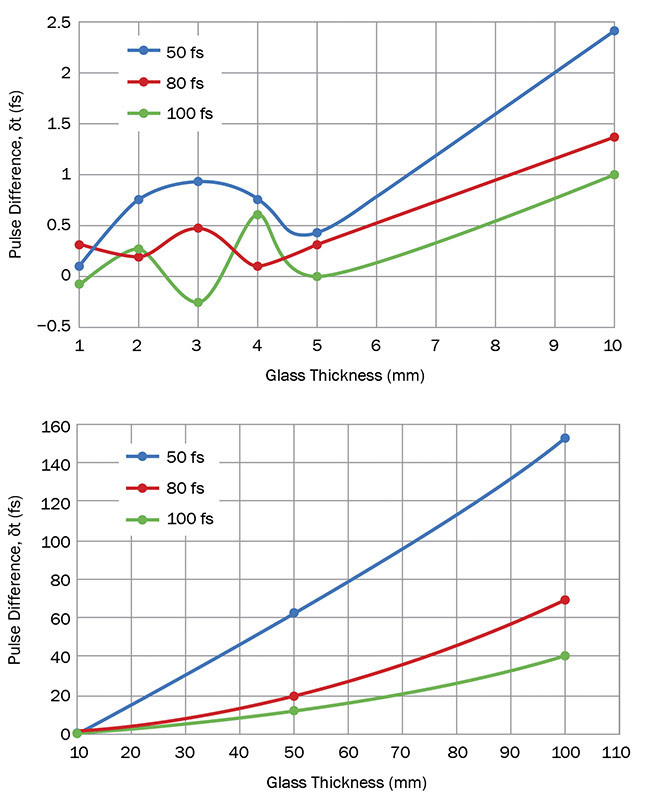
Figure 3. Pulse spreading through 1- to 10-mm-thick blocks (top) and through 10- to 100-mm-thick blocks (bottom). Courtesy of Optical Surfaces Ltd.
Nevertheless, the need to deliver a high-precision, in-phase, free-of-aberration, and highly dense spot of light at the focal plane obliges the users to adopt optics with large apertures and short focal lengths. These demands can only be satisfied by the use of highly aspheric lenses and mirrors, which are naturally free of spherical aberrations.
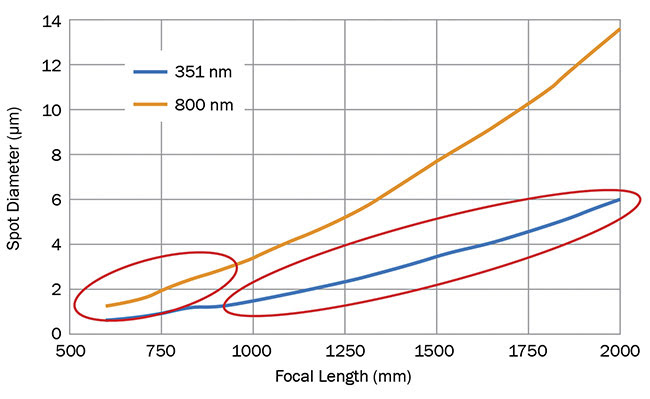
Figure 4. The relationship between focal length and focused spot diameter for a given input beam diameter. The blue line represents a scenario similar to the NIF’s operational needs, where multiple short-pulse beams at 351 nm converge toward the target. The orange line represents a scenario similar to ELI’s, where a single high-peak-power ultrashort shot is delivered at 800 nm. Courtesy of Optical Surfaces Ltd.
The correct selection of optics can assist in delivering a precise spot of light only a few microns in diameter at the target
(Figure 4). The calculations assume a perfect Gaussian beam of 300-mm-diameter aperture, perfect optics, and Gaussian beam propagation theory (Figure 5). In
nuclear laser facilities, an aspheric focusing lens with a focal length of 1 to 3 m may be considered to be an appropriate choice (depending on the diameter of
the chamber, number of beamlines used, and other design parameters). However, an off-axis parabolic mirror with a very
short focal length may be considered the most appropriate — also for a number
of additional reasons not addressed here in detail.
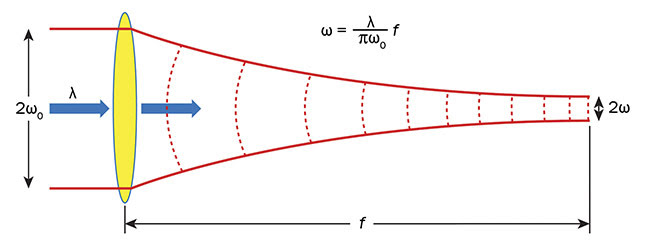
Figure 5. Gaussian beam propagation theory applied to a beam going through a focusing element. Courtesy of Optical Surfaces Ltd.
Considering the particular example of ELI, it was possible to extrapolate further and ascertain that the focal length of the required off-axis parabolic mirror would have to lie within the region of 700 mm (Figures 6 and 1) to permit generation of ultrarelativistic plasma according to the aspirations of the designers. This objective relates to the target of achieving focusing intensities that aim to exceed
the 1023 W/cm2 barrier.
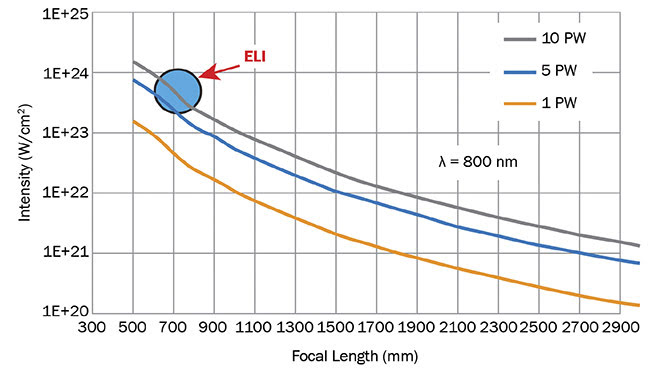
Figure 6. Graph illustrating the need to resort to very high-power petawatt lasers and a very short focal length mirror to generate ultrarelativistic plasma (ELI). Courtesy of Optical Surfaces Ltd.
Meet the author
Aris Kouris (DPhil, MSc, BSc) has been sales director for the past 11 years at Optical
Surfaces Ltd., a Surrey, England-based company that specializes in the manufacturing of large and demanding optics and instruments for fundamental physics, astronomy, space,
and defense. He has a doctorate in optical
engineering from the University of Sussex; email: [email protected].
References
1. G.A. Mourou et al. (2007). Relativistic laser-matter interaction: from attosecond pulse generation to fast ignition. Plasma Phys Control Fusion, Vol. 49, p. B667.
2. T.Z. Esirkepov et al. (2012). Fundamental physics and relativistic laboratory astrophysics with extreme power lasers. EAS Publ Ser, Vol. 58, pp. 7-22.
3. J. Yee and S.T. Cundiff (2005). Femtosecond Optical Frequency Comb Technology: Principle, Operation and Applications. Boston: Springer Science + Business Media Inc., p. 55.
4. G.A. Mourou et al. (2011). ELI-Extreme Light Infrastructure — Whitebook: Science and Technology with Ultra-Intense Lasers. ELI PP Publications.
5. N. Hopps et al. (2013). Overview of laser systems for the Orion facility at the AWE. Appl Optics, Vol. 52, No. 15, pp. 3597-3607.
6. M. Rosete-Aguilar et al. (2008). Calculation of temporal spreading of ultrashort pulses propagating through optical glasses. Rev Mex Fis E, Vol. 54, No. 2, pp. 141-148.